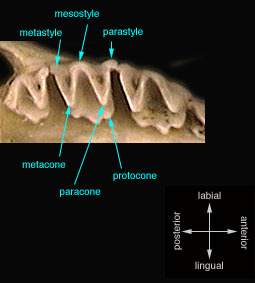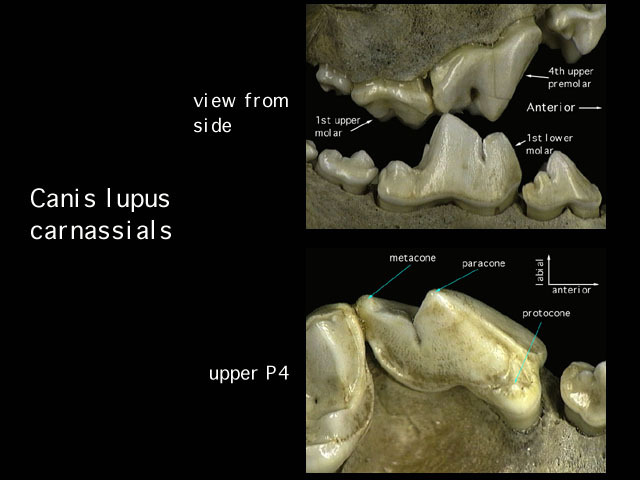The Diversity of Cheek Teeth
The teeth of living marsupials and placentals are believed to have evolved from tribosphenic teeth:
|
upper tribosphenic molar 
|
lower tribosphenic molar 
|
In the tribosphenic teeth of the upper jaw, the three main cusps are the protocone, paracone, and metacone. A shelf called a cingulum runs around the lingual side of the protocone. A small shelf named the stylar shelf runs along the (lip) side of the tooth. On it are located several smaller cusps (the and others). These outer cusps may be connected to each other, the paracone and the metacone by a ridge called an ectoloph. In lower tribosphenic teeth, we recognize a trigonid formed by three main cusps, the paraconid, protoconid, and metaconid. Posterior to it is the talonid basin. The talonid basin also has three cusps, the hypoconid, hypoconulid and entoconid. These terms and structures are described in more detail in the section on The Basic Structure of Cheek Teeth.
This pattern is believed to be primitive for mammals, and we can still see the vestiges of it in the teeth of many species. In this section, we will go over some of the ways in which tribosphenic teeth have been modified. Keep an eye on how the main cusps are changed as mammals adapt to different feeding styles and food consistencies.
A zalambdodont upper molar is characterized by a V-shaped crest (an ectoloph). The largest cusp is at the apex of the V (on the lingual or tongue side of the tooth). This cusp is believed to be homologous with the paracone of a tribosphenic tooth (although in a zalambdodont tooth the paracone is sometimes probably fused with the metacone). The crests that make up the ectoloph run to smaller cusps located on an expanded shelf on the labial side of the tooth, which is called the stylar shelf. The protocone is typically missing. Zalambdodont teeth are found, for example, in golden moles (Chrysochloridae) and solenodons (Solenodontidae).
A dilambdodont upper molar is also characterized by a well-developed ectoloph, but in this case the ectoloph is W-shaped. At the bottom of the W are the metacone and paracone. Crests run from these cones to cusps on the stylar shelf to form the rest of the W. A protocone sits apart, not part of the ectoloph and lingual to it. Examples of mammals with dilambdodont teeth include shrews (Soricidae), moles (Talpidae), and many insectivorous bats (e.g., Vespertilionidae).
|
Zalambdodont 
|
Dilambdodont 
|
A change that occurred early in mammalian history is the addition of a fourth main cusp, the hypocone, to the upper molar. The hypocone is located on the lingual side of the tooth, posterior to the protocone. Its addition results in a more-or-less square surface. Upper teeth with four main cusps, protocone, paracone, metacone, and hypocone, are termed quadrate, quadritubercular, or euthemorphic. These teeth are found in many kinds of mammals. Especially good examples can be seen in hedgehogs (Erinaceidae), raccoons (Procyonidae), and many monkeys (e.g., Hominidae, Cercopithecidae, Cebidae).
Quadrate (=euthemorphic) teeth of a hedgehog

Another common change is the addition of small cusps () between the larger ones. Examples include a (between paracone and metacone) and the already-mentioned hypoconulid (between hypoconid and entoconid). These teeth belong to a red panda (Ailurus fulgens, Ursidae)

Mammals that feed on abrasive substances are subject to rapid wear on their teeth. Many of these species have especially high-crowned teeth, that is, teeth that extend unusually far above the gumline, providing lots of extra material for wear. These teeth are called hypsodont. The teeth of cows and horses are hypsodont. The opposite condition, low-crowned teeth, is termed brachydont. Human teeth are brachydont. In some species, hypsodont teeth continue to grow throughout an animal's life (e.g., many species of the rodent subfamily Arvicolinae, family Muridae).
Herbivores must efficiently and thoroughly grind their food, which is many cases is hard and abrasive. The addition of hard enamel ridges to the teeth improves their grinding action. These teeth are often either lophodont or selenodont. Lophodont teeth have elongated ridges called lophs that run between cusps. Lophs may be oriented antero-posteriorally, or they run between labial and lingual parts of the tooth. The molars and premolars of tapir (Tapiridae), manatees (Trichechidae), and many rodents are lophodont. Extreme lophodonty is seen is modern elephants (Elephantidae) and some rodents (Hydrochoerus, fam. Hydrochaeridae; Otomys, fam. Muridae). In these forms, the teeth look like an old-fashioned washboard, a condition referred to as loxodont.

|

|
In the simplest cases, such as the tapir (above), it is still easy to identify protocone, paracone, metacone, and hypocone. In more extreme cases this is no longer possible.
A common lophodont pattern in primates is for the surface of the tooth to be made up of two main transverse lophs, a condition called bilophodont or biscuspid (e.g., Cercopithecidae). In the baboon, below, the lophs run between protocone and paracone and between hypocone and metacone.

Another means of increasing the number and size of enamel cutting surfaces is to elongate the primary cusps in an anterior-posterior direction. The resulting teeth are called selenodont. The cheek teeth of deer (Cervidae) and cattle (Bovidae) are selenodont.

Many mammals, including humans, pigs, bears, and raccoons, have roughly quadrate (euthemorphic upper) cheek teeth with low, rounded cusps. The lower teeth are also quadrate, usually as a result of the loss of the paraconid (so that the four major cusps are the protoconid, metaconid, entoconid, and hypoconid). These upper and lower cheek teeth are termed bunodont. Species with bunodont teeth often have broad diets consisting of many different kinds of foods with different consistencies. In addition to hominids (Hominidae), bear (Ursidae), raccoons (Procyonidae), pigs (Suidae), and many other kinds of mammals have bunodont teeth.

The fourth upper premolar and first lower molar in the jaws of many (but not all!) modern Carnivora are enlarged and bladelike. Termed carnassial teeth, they are used for slicing and chopping. When a dog or cat brings the side of its head up against a bone on which it is gnawing, it is probably using its carnassials.

A general term for bladelike teeth is secodont or plagiaulacoid. Such teeth are also found in some herbivores. The next image shows the plagiaulacoid of a macropodid marsupial (Macropodidae) (and as well, a series of bilophodont molars).
